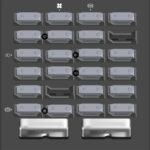Modernizing your vehicle with a digital dash offers a sleek, high-tech upgrade, providing real-time insights into your car’s performance. But to truly leverage the power of a digital dash, you need a reliable way to access your vehicle’s data. This is where the Digital Dash Obd2 connection becomes crucial, and the BIM-01-2 OBD-II Interface emerges as a key solution.
The BIM-01-2 OBD-II (J1850/CAN) Interface is engineered to connect directly to your car’s diagnostic port, tapping into the engine control module (ECM) to retrieve essential engine and transmission data. This clever device acts as a translator, converting complex vehicle signals into a format compatible with Dakota Digital Instrument Systems, allowing you to display critical information on your new digital dash.
With the BIM-01-2, you can monitor a range of parameters, depending on your vehicle’s capabilities. Most vehicles will readily provide:
- Speedometer: Accurate speed readings for your digital display.
- Tachometer: Keep track of your engine’s RPM in a modern format.
- Engine Temperature: Essential for monitoring engine health and preventing overheating.
- Check Engine Indicator: Integrate your vehicle’s diagnostic warnings directly into your digital dash.
Beyond these standard readings, the BIM-01-2 can potentially access vehicle-specific data, depending on your car’s sensors and ECM configuration. This may include valuable metrics such as:
- Intake Air Temperature: Monitor the temperature of air entering your engine.
- Transmission Temperature: Crucial for vehicles that work hard or tow, helping to prevent transmission damage.
- Ambient Air Temperature: Display the outside temperature on your digital dash.
- Gear Position: Know your current gear selection at a glance.
- Oil Pressure: Keep an eye on your engine’s oil pressure for optimal lubrication.
- Boost Pressure: For turbocharged vehicles, monitor boost levels for performance and tuning.
It’s important to note that while the BIM-01-2 is designed to extract a wide range of data, the availability of specific parameters like Intake Temp, Transmission Temp, Ambient Air Temp, Oil Pressure, and Gear Position is ultimately dictated by your vehicle’s ECM and factory-installed sensors. Dakota Digital emphasizes that they cannot guarantee the presence or accuracy of these additional data points, as it’s dependent on the OEM specifications of your vehicle.
The BIM-01-2 is specifically compatible with GRFX, RTX, HDX, VHX, and VFD3 Dakota Digital instrument systems that utilize a black plastic control module. For older BIM-compatible control boxes featuring a 3.5mm headphone jack BIM input, a 394194 adapter harness is required. It is crucial to understand that earlier instrument systems with an aluminum control module are not compatible with BIM connectivity.
This interface is designed for vehicles using J1850 and CAN OBD-II protocols, supporting SAE J1850 VPW, SAE J1850 PWM, and ISO 15765 CAN 500k 11-bit identifiers adhering to the SAE J1979 PID protocol. If you are unsure about your vehicle’s compatibility with the BIM-01-2, it is recommended to contact sales or technical support for clarification before purchase.
A specific limitation to be aware of is that GM Connect & Cruise packages do not transmit gear position data, which means the BIM-01-2 will not be able to acquire this information in those applications.
In conclusion, the BIM-01-2 OBD-II Interface provides a robust and effective solution for integrating your vehicle’s data with Dakota Digital digital dash systems. By tapping into the OBD2 port, it unlocks a wealth of information, enhancing the functionality and appeal of your digital dash upgrade. For car enthusiasts and those looking to modernize their vehicle’s instrumentation, understanding the capabilities and compatibility of digital dash OBD2 interfaces like the BIM-01-2 is essential.
